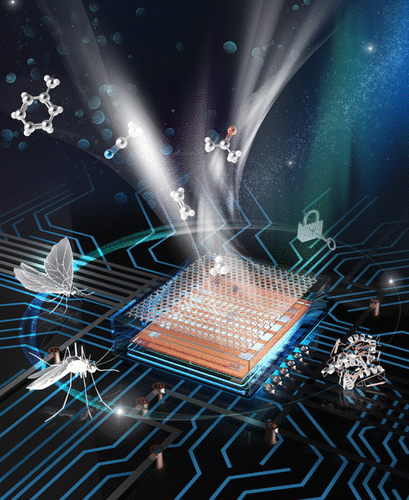Researchers at the Technion and in China present a hybrid sensing array for continuous monitoring of health data, combining artificial intelligence and cloud computing

Researchers at the Technion and Shidian University in China present, in the prestigious journal Chemical Reviews, a comprehensive review of smart systems that provide continuous information on the subject's health status. These systems are based on an advanced hybrid sensing array and artificial intelligence and cloud computing.
A significant part of the review is based on the research works of the authors, led by Prof. Hussam Haik and Dr. Yoav Baroza from the Wolfson Faculty of Chemical Engineering at the Technion and Prof. Weiwei Wu from Shidian University.
Wearable monitoring is an umbrella term for innovative technologies that provide information about a person's health status, based on the continuous monitoring of a series of biological markers. The rapid development of this field is very important news, especially in view of the rapid increase in the elderly population and the fact that people aged 60 and over currently make up about 13% of all humanity.
However, for various reasons, the diagnostic technologies develop in different channels, without a guiding hand and without integration of the various data obtained from them. Such integration is a condition for optimizing diagnosis, treatment and follow-up. In the absence of such integration, and despite the developments in the field of medical diagnosis, in many cases the diagnosis is made very late, which reduces the ability of the medical system to treat the problem successfully. Even preventive medicine, one of the most important approaches in the world of medicine, is not progressing at the proper speed.
The extension of life, which is blessed in itself, shifts the center of gravity from serious, short-term and curable diseases, which originate from external factors such as infections and injuries, to long-term, incurable chronic diseases, which harm the quality of life over time. Today, almost 45% of all Americans suffer from chronic diseases, and the need for continuous and integrative monitoring is especially important in this context.
This is the background for the great effort invested in recent years in the research group of Prof. Hussam Haik. In the present report, the group's researchers, in collaboration with Prof. Vivi Wu who did his post-doctorate under the guidance of Prof. Haik, present an in-depth and extensive review of innovative sensors that were developed inspired by nature and provide fast and cheap diagnosis with minimal invasiveness. In this review, the researchers present a complex system that analyzes, with technological means including cellular, cloud and big data analytics, a series of biological markers originating from body fluids - blood, tears, saliva, sweat, saliva, urine, cerebrospinal fluid and more. The overall goal of this research activity is the development of hybrid sensing arrays that combine different sensing technologies. For this, a combination of different fields of knowledge is needed, including chemistry, electronics, and physics - a combination that takes place in Prof. Haik's research group.
According to Prof. Haik, "Until today, the most reliable means of diagnosis have been radiological diagnosis (eg x-rays, MRI, CT), laboratory tests (of urine, blood samples, etc.) and various microbiological tests. The problem is that these are expensive methods that require experts to decipher the findings. The technological development allows us to present cheap, fast and accurate automatic methods that collect a wide variety of data and analyze them. Through the integration of various technological capabilities, we present an inexpensive, simple-to-use and effective monitoring tool that will provide caregivers with comprehensive and continuous feedback on the subject's health status."
One of the essential conditions for achieving this goal is the development of particularly sensitive and accurate sensors. Here, according to Prof. Haik, comes inspiration from nature. "For billions of years, evolution has developed excellent and efficient sensors, based, for example, on the interaction between enzymes and receptors and on suction systems such as the hummingbird's tongue. We not only drew inspiration from these mechanisms, but engineered better systems. To all this we connect technologies such as artificial intelligence, IoT and cloud computing. The bottom line is a complex system that will provide the relevant medical provider with a comprehensive and accurate continuous diagnosis in real time and recommendations for early and effective treatment."
Prof. Hussam Haik is the head of the laboratory for nanomaterials-based devices in the Wolfson Faculty of Chemical Engineering and a member of the Russell Berry Nanotechnology Institute (RBNI). The present study was conducted with the support of the European Union 2020 Framework Program for the VOGAS consortium and the A-PATCH consortium.
For an article in the journal Chemical Reviews
More of the topic in Hayadan:
